


Devilsticking originated in China and is now commonplace in most juggling clubs. The idea is very simple: keep one large tapered stick in the air with two smaller handsticks. Devilsticks are not as readily available as other juggling props, but they are stocked by most juggling suppliers; prices range from £5 to £35. Most devilsticks are decorated in metallic tape, and handsticks usually have a silicone coating for a good grip. Flaming versions are available for the brave.
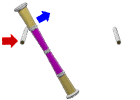 The basic devilstick pattern is to keep the tapered stick in the air by alternately hitting it with the two smaller sticks. Start by kneeling on the floor, holding a handstick in a each hand, parallel and horizontal. Rest the devilstick at about three-quarters of its length on the end of the right handstick. Using the right handstick tap the devilstick horizontally, so that it come to rest against the left handstick. Repeat this motion in quick succession, making sure at each tap, the devilstick makes contact with the handstick at about three-quarters of its length.
The basic devilstick pattern is to keep the tapered stick in the air by alternately hitting it with the two smaller sticks. Start by kneeling on the floor, holding a handstick in a each hand, parallel and horizontal. Rest the devilstick at about three-quarters of its length on the end of the right handstick. Using the right handstick tap the devilstick horizontally, so that it come to rest against the left handstick. Repeat this motion in quick succession, making sure at each tap, the devilstick makes contact with the handstick at about three-quarters of its length.
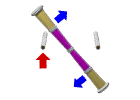 The secret of getting the devilstick to leave the ground is to tap upwards with the devilsticks instead of horizontally. Start as above, but this time tap the devilstick upwards: sometimes it is helpful to imagine the handsticks as unable to move horizontally. With practise, the devilstick should lift off the ground after a couple of taps.
The secret of getting the devilstick to leave the ground is to tap upwards with the devilsticks instead of horizontally. Start as above, but this time tap the devilstick upwards: sometimes it is helpful to imagine the handsticks as unable to move horizontally. With practise, the devilstick should lift off the ground after a couple of taps.
Once the devilstick is in the air it is important to work on style. Most beginners knock the devilstick from side to side and the stick does not rotate much at all. Try and keep the centre of the devilstick almost stationary, so that the is rotating rather than moving. Get the devilstick to turn through as much angle as possible: you should be able to get the devilstick to be almost horizontal when hitting it so that it sweeps through 180° between hits. This has the effect of slowing down the whole action making it easier to control: two taps per second is a reasonable speed.
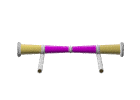 It is very easy to hold the devilstick steady across the two handsticks as shown in the diagram. This a very useful way of pausing during a routine, and it is easy to swap from normal devilsticking to holding the devilstick steady. From the stationary position, try tapping the right end of the devilstick so that it does half a spin in th air before catching it on the two handsticks again. Once you’ve mastered this try a full spin. A further variation is to keep the handstick in contact with the devilstick during the spin; this gives you more control over the motion.
It is very easy to hold the devilstick steady across the two handsticks as shown in the diagram. This a very useful way of pausing during a routine, and it is easy to swap from normal devilsticking to holding the devilstick steady. From the stationary position, try tapping the right end of the devilstick so that it does half a spin in th air before catching it on the two handsticks again. Once you’ve mastered this try a full spin. A further variation is to keep the handstick in contact with the devilstick during the spin; this gives you more control over the motion.
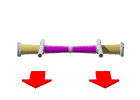 Even the best of us are bound to make mistakes from time to time, so it is useful to be able to quickly start again after dropping. One way is to place the two handsticks on top of the devilstick as shown and then pull them back. When they roll off the devilstick, move them down and the devilstick should roll onto them. This leaves you at the stationary position above. An even more flashy start is to do this with only one stick and then go directly into normal devilsticking: this looks especially good if you can start with a full spin! Those of you familiar with kick-ups in club juggling may like to try kicking up the devilstick.
Even the best of us are bound to make mistakes from time to time, so it is useful to be able to quickly start again after dropping. One way is to place the two handsticks on top of the devilstick as shown and then pull them back. When they roll off the devilstick, move them down and the devilstick should roll onto them. This leaves you at the stationary position above. An even more flashy start is to do this with only one stick and then go directly into normal devilsticking: this looks especially good if you can start with a full spin! Those of you familiar with kick-ups in club juggling may like to try kicking up the devilstick.
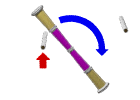 During normal devilsticking, the devilstick does a half spin between successive taps. Try hitting the devilstick slightly harder so that it does a full spin between taps. To begin with try doing the occasional full spin, then try doing full spins on every tap from the right hand; you should then be able to try constant full spins. It is possible to one-and-a-half spins or even double spins, but these put a lot of pressure on the handsticks which are usually not very sturdy. Remember that style is a lot more important than power!
During normal devilsticking, the devilstick does a half spin between successive taps. Try hitting the devilstick slightly harder so that it does a full spin between taps. To begin with try doing the occasional full spin, then try doing full spins on every tap from the right hand; you should then be able to try constant full spins. It is possible to one-and-a-half spins or even double spins, but these put a lot of pressure on the handsticks which are usually not very sturdy. Remember that style is a lot more important than power!
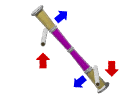 One way to have more control over the devilstick is to make double contact with the devilstick at each tap. When you hit the devilstick up with the right hand, hit the other end of the devilstick down with the left hand simultaneously. Using this technique you have more freedom of where you can tap the devilstick: it is possible to get the devilstick to rise up by hitting the lower half of it with both handsticks. Double contact is one way to get the devilstick spinning in a flat circle: see the section on helicopters below for more details.
One way to have more control over the devilstick is to make double contact with the devilstick at each tap. When you hit the devilstick up with the right hand, hit the other end of the devilstick down with the left hand simultaneously. Using this technique you have more freedom of where you can tap the devilstick: it is possible to get the devilstick to rise up by hitting the lower half of it with both handsticks. Double contact is one way to get the devilstick spinning in a flat circle: see the section on helicopters below for more details.
Some of the best tricks with the devilstick use only one handstick. Try out some of the moves below.
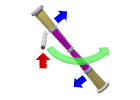 Try normal devilsticking, but use the right handstick in place of the left handstick by quickly moving it across. This has to be done very quickly and takes a lot of practice. It is often quite difficult to move the handstick around devilstick and the motion can look ugly.
Try normal devilsticking, but use the right handstick in place of the left handstick by quickly moving it across. This has to be done very quickly and takes a lot of practice. It is often quite difficult to move the handstick around devilstick and the motion can look ugly.
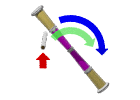 A much better variation of the above is to do constant full spins. Follow through with the handstick in a circular arc after hitting the devilstick: the handstick should then be in the right place for making the next tap.
A much better variation of the above is to do constant full spins. Follow through with the handstick in a circular arc after hitting the devilstick: the handstick should then be in the right place for making the next tap.
Helicopters involves keeping the devilstick moving in a flat horizontal flat spin using only on handstick. Firstly get the devilstick moving in a flat spin: there are three methods of varying difficulty that achieve this. The most basic starts from the stationary position above: push the left handstick forward and pull the right handstick backward. Although this doesn’t look very impressive in the middle of a routine, it is a good way to practise helicopters as it is an easy way to create a slow, controlled spin. The second method starts from the double contact pattern: during the time the devilstick is in contact with the handsticks, push the left handstick forward and pull the right handstick backward. For the third method, tilt the left handstick downwards and the right handstick upwards in normal devilsticking. As the devilstick rolls off the handsticks it should start to spin in a circle. It is possible to push and pull as in the other two methods as well, and with plenty of practise the technique can give a fearsome rate of spin. Move one of the handsticks away to start the helicopter. Every time the devilstick is perpendicular to the handstick, hit it upwards at the centre tape. With a good starting spin it is possible to keep up the helicopter for around fifteen seconds. After the spin has been lost, try speeding it up again by going back to two sticks. There are several extensions to these ideas. Try missing a beat during the helicopter so that it does a full rotation between taps. Also, try doing full spins in the third method described above: if you can keep up constant full spins, then the pattern looks very much like helicopters alternating the two handsticks.
Propellers is one of the most satisfying devilstick tricks, and involves keeping the devilstick spinning constantly in a vertical plane using only one handstick. Start from normal devilsticking, and hit the devilstick hard with the left handstick so that the devilstick goes into a full spin. When the devilstick is horizontal, hit it with the right handstick just left of the centre tape to keep the rotation going. Follow the devilstick around with handstick, and when they have completed a full rotation hit the devilstick in the same place again. This technique is quite tricky to learn and requires perseverance. A common mistake made by beginners is to try and keep the handstick in contact with devilstick for the whole rotation but the two should only come into contact once in a full revolution: it feels very much like a ‘scooping’ action.
You can use body moves to make many of the devilstick tricks look more impressive. Try the tricks with arms crossed, one hand under the leg or one hand behind the back. If your devilstick has rubbery end caps and you are practising on a suitable surface, try bouncing the devilstick off the ground during a trick. The devilstick is a useful prop for balancing. Once you’ve mastered balancing the devilstick on the finger, try balancing on the chin, or on the foot. During a devilstick routine it is possible to flip in and out of these positions. A very interesting variation worth a mention (although not much to do with devilsticking) is to try baton twirling.
Unlike many other juggling props the devilstick does not lend itself to tricks with more than one person very well, and there are only a few worth mentioning. There are several positions where a second person holds one of the handsticks and devilsticking continues normally. This can be done by the people standing side by side or opposite one another. All the usual tricks can be done: the second person just takes over the control of left handstick.
For other variations, each person has two handsticks. One person starts with the devilstick and then passes it to the other person; alternatively the second person can ‘steal’ the devilstick off the first person. Once this has been mastered, each person can start with a devilstick.
The tricks shown above are only the tip of the iceberg. If you think you’ve mastered the devilstick, some of the tricks below may make you think again!
It is possible to keep two devilsticks going with two handsticks by hitting them out of step: this is best seen in the diagram. Start as in normal devilsticking and rest the second devilstick on the other handstick. Try to keep each devilstick in a separate vertical plane to avoid them hitting one another. This is extremely tricky to do, as it is very hard to keep the two devilsticks out of step. It is probably best to use two devilstick of the same make, so that they have the same weight distribution. Another two devilstick trick is double propellers: if you can manage propellers with the left and right hand, try keeping a propeller going in each hand simultaneously.
According to some sources, it is possible to do a devilstick propeller using the index finger in place of the handstick. This is not easy, as unless you’ve got long fingers the rest of the hand gets in the way.
Don’t even ask!